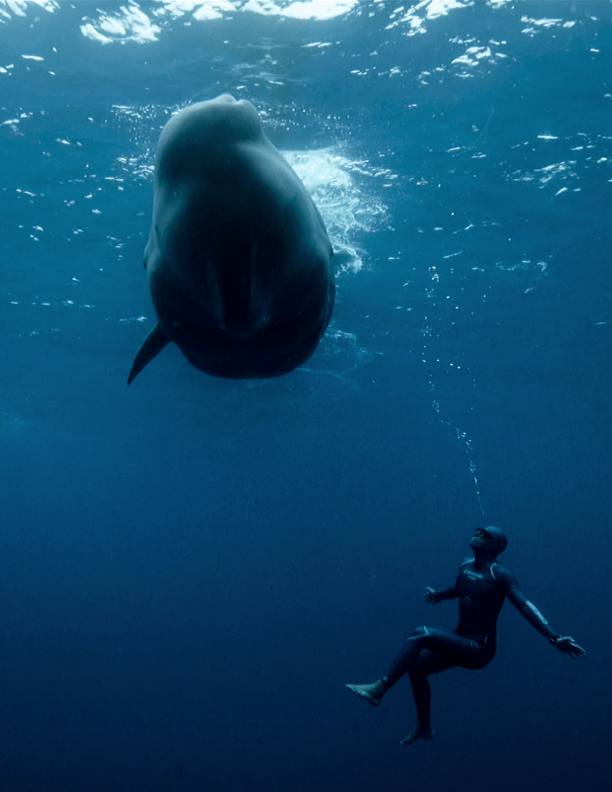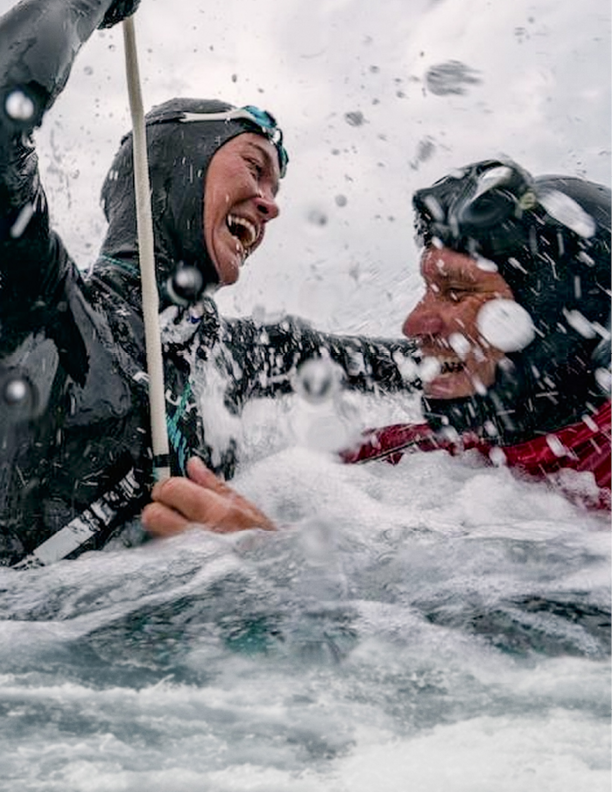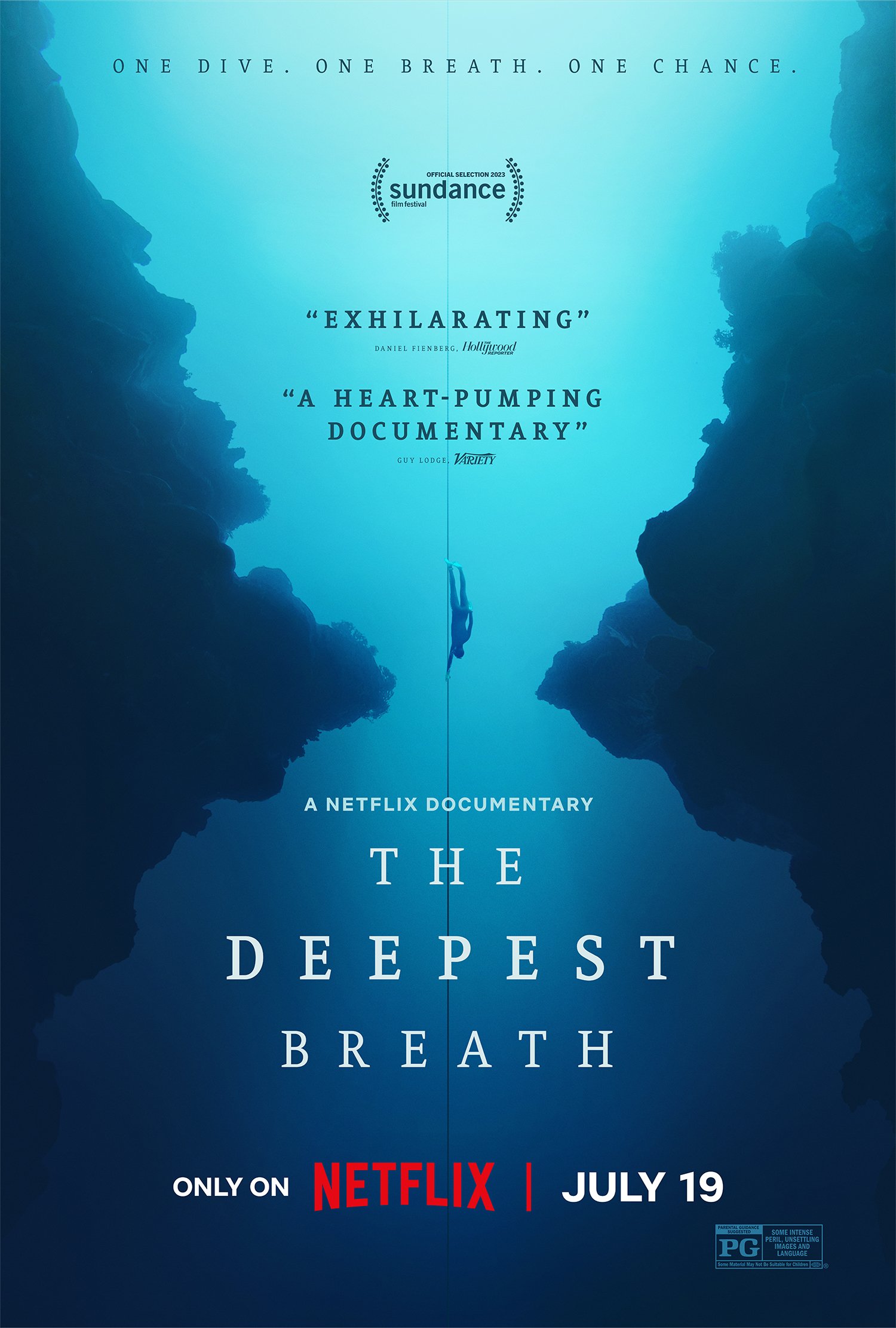Prior to the release of Netflix's The Deepest Breath, we had the pleasure of watching the screener for this documentary film that not only brings us into the world of freediving, the relationships between freedivers as well as safety divers, but the dedication and the complete use of the athlete's body when they are competing. We are introduced to Alessia Zecchini who is known as the Deepest Women on Earth at 123 meters, 38X Freediving World Record, and 17X World Champ. We also meet her safety, Stephen "Steve" Keenan who was passionate about this sport as well as protecting the freedivers who continue to trailblaze in this sport.
For those that may not be aware, we wanted to give a bit of background on the sport as well as some terminology. Freediving is the practice of holding your breath when diving underwater without the use of breathing equipment, such as a scuba tank. This takes on more meaning when you realize that prior to Alessia winning the 2023 AIDA Oceanquest Philippines in Camotes Island, she broke a world record in the Bifins discipline during the 2023 Secret Blue International Depth Competition in the Philippines by achieving a 109 meter dive in 3 mins and 38 seconds. She broke her own 2-day old record of 107 meters set on a 3 min 26 sec dive in March and surpassed the previous AIDA record by a 10meter margin. Her world and Italian records are definitely astounding and even more so when you realize that this is done by simply holding your breath as depths are being navigated!
In this sport, there are blue holes which are a large marine cavern or inkhole, which is open to the surface and has developed in a bank or island composed of a carbonate bedrock. They can be an oasis in an otherwise barren seafloor. Blue holes are diverse biological communities full of marine life, including corals, sponges, mollusks, sea turtles, sharks, and more.
If you have yet to see this documentary film, you can stream this now on Netflix, but this interview may have spoilers. We sat down with the film's director, Laura McGann to find out about why she wanted to share this true story, bring this sport to life, show how one trains to do it, and to transport us to phenomenal locales around the world.
ATHLEISURE MAG: What drew you to want to direct The Deepest Breath and how did you find out about this story?
LAURA MCGANN: Look, I love the sea and we moved to live by the sea because we love swimming all year around and it gives me a lot. I’m a better person for the sea for sure!
So I suppose, that I would be attracted to anything about it and I remember seeing it in the Irish Times and I didn’t know what freediving was and I had to Google it. I was met by these incredible images of humans behaving more like dolphins and holding their breath for what felt like forever. It was kind of like learning that there was a group of people who had cracked the code on flying and that they had just learned how to fly! I was like, what? So it started there and then I learned more about Steve and Alessia, that’s when I really felt like, oh God this could be an incredible story, an incredibly cinematic documentary and if I were possibly able to tell it in the moment, and go on their journey with them – Alessia the World Champion freediver and Stephen Keenan an expert safety diver and their lives are just so incredibly dramatic and also just really inspirational. Just seeing that if you just live your life a little bit differently, follow your dreams – what it is that you can end up doing!
AM: When we first heard about the movie, there was a general sense of what freediving was but the first 5 or 10 minutes of actually watching your film, you get the depth of the intensity of what the film as well as what the sport is about! It really puts you in awe about all the things that have to come together to compete in this with holding that breath and really using your body as an instrument.
How did you immerse yourself in being able to really know about what the sport is and to get those moments so that as a viewer, you’re able to translate those anxiety filled moments as you’re watching it?
LM: Well, I suppose I came to this not knowing anything. It was really a long time before I would see a freediver with my own 2 eyes! It would actually be years, about 3 years and so the free divers from all over the world, held my hand and spent many an hour explaining to me over Zoom on what they did, why they did it, how they did it and how it all was. Then eventually, the first place that we went to where I saw Alessia dive was in fact the Blue Hole in Dahab, Egypt. One of our participants in the film, Kristof Coenen, he describes it as like putting his head in the water for the first time and holding his breath and all the shit from daily life just vanishes. I was at the Blue Hole and I looked in the water and I saw all of the little fish and the coral and I was only up to about my hip, but then I swam about 5 meters out and then all of a sudden, it just drops like a cliff for about 100 meters deep from 1 meter to 100 meters – just like that! It was an incredible blue, the kind of blue that calls you down and so getting to see that for myself, experience it for myself, I think it was really important as the filmmaker that I could kind of grasp something from it and try to bring that onto the screen.
AM: From an organizational standpoint, the way that the film reveals itself is really interesting and it tells a deeper story. You have so many people that talk throughout this film. How did you coordinate it all as it must have been massive?
LM: I suppose that part of it was that we had the pandemic which stopped us from doing a lot, but it also allowed us to do a lot as well in terms of the research and being able to spend so much time talking to them. It allowed us the time to really sit with the story and I would use our Zoom transcripts to piece together, kind of as a script to see what people were saying and to figure out the best way to tell this story in the most compelling way and to try to figure that out. And really, just to do it justice.
AM: What’s the big story that you want people to walk away from in terms of having the freediver and having the safety diver, what is it that we should be getting from that?
LM: I suppose that one of the things is to open people’s eyes up to what humans can actually do as that’s just fascinating! To watch that play out in someone’s life, to see them develop the skill, but it’s also like, 2 people that had this wild streak, this curiosity for the life and this world and just living their life in a way that was different from the way that it was expected or would have liked from their parents. Going on that journey with them is a bit like living vicariously through Steve and Alessia and doing something that maybe a lot of us would not be brave enough to do, but perhaps should be!
AM: We’re taken on a journey of a number of locations in this film. What were all of the locations?
LM: Oh my God, it was incredible! Freedivers know how to choose locations and they were more like that of a Bond film! So we started in the Blue Hole in Dahab and we went to Dean’s Blue Hole on Long Island in the Bahamas – it’s a 200m sinkhole. It’s just stunning. We went to a number of cenotes (Editor’s Note: Cenotes are a natural pit, or sinkhole resulting from the collapse of limestone bed rock that exposes groundwater. This term originated in the Yucatan Peninsula of Mexico, where cenotes were commonly used for water supplies by the ancient Maya.) in Mexico. I didn’t even know what a cenote was and looking at some of the footage from Daan Verhoeven, he’s a freediving cinematographer – I had seen these incredible images. Our main image is of Alessia swimming up towards the light in a cenote and I remember seeing images like this from Daan and asking him, “Daan, what’s this?” He explained that it was a cenote in Mexico. So it was just such an incredible learning curve for me. Then, filming off of the Caribbean Sea off of Mexico as well with the freedivers along with incredible freediving cinematographer Julie Gautier, she would with the safety and the divers, dive down to 30m, pop back up, show me the shot, I would be holding onto a noodle on the surface and I’d say, “that’s great Julie, could we just do that one more time, slightly different?” She’d say yes and pop back down to 30m and then come back up again. It was like having a fleet of dolphins on our crew. That’s what it was like!
AM: What was your favorite moment of this production?
LM: Oh God, there has been many really! Many moving moments. I would struggle now to name 1. It was in the Blue Hole in Dahab and as I said, it was our first shoot and it was my first opportunity to see what it was all about and it was swimming out over that cliff like I was saying to you. There was that moment when I was looking down at the fish and then it broke down and away into 100m. It was just this blue that went on for forever! It looked more like you were looking into the sky or something and you could see for 30 or 40m. You could see fish and that was just a moment that I will never be able to forget for my entire life! There were core memories made there in that moment.
AM: What was the most difficult part of this production?
LM: For me, I would say, getting it right. It was really important to me, not just as a filmmaker, and as a film that people would be able to get something from and enjoy. But for the people that are in it. It was just really important to me that Peter, Steven’s dad and his family, Alessia and her family were happy and felt like it reflected their memories of what happened and that it was true and it was fair. That was something that was always at the forefront of my mind and it was really important.
I wouldn’t say that it was a difficult thing, I would say that it was extremely important that we would have to look after.
IG @netflix
PHOTOGRAPHY COURTESY | Netflix/The Deepest Breath
Read the JUL ISSUE #91 of Athleisure Mag and see THE DESCENT | Laura McGann in mag.







